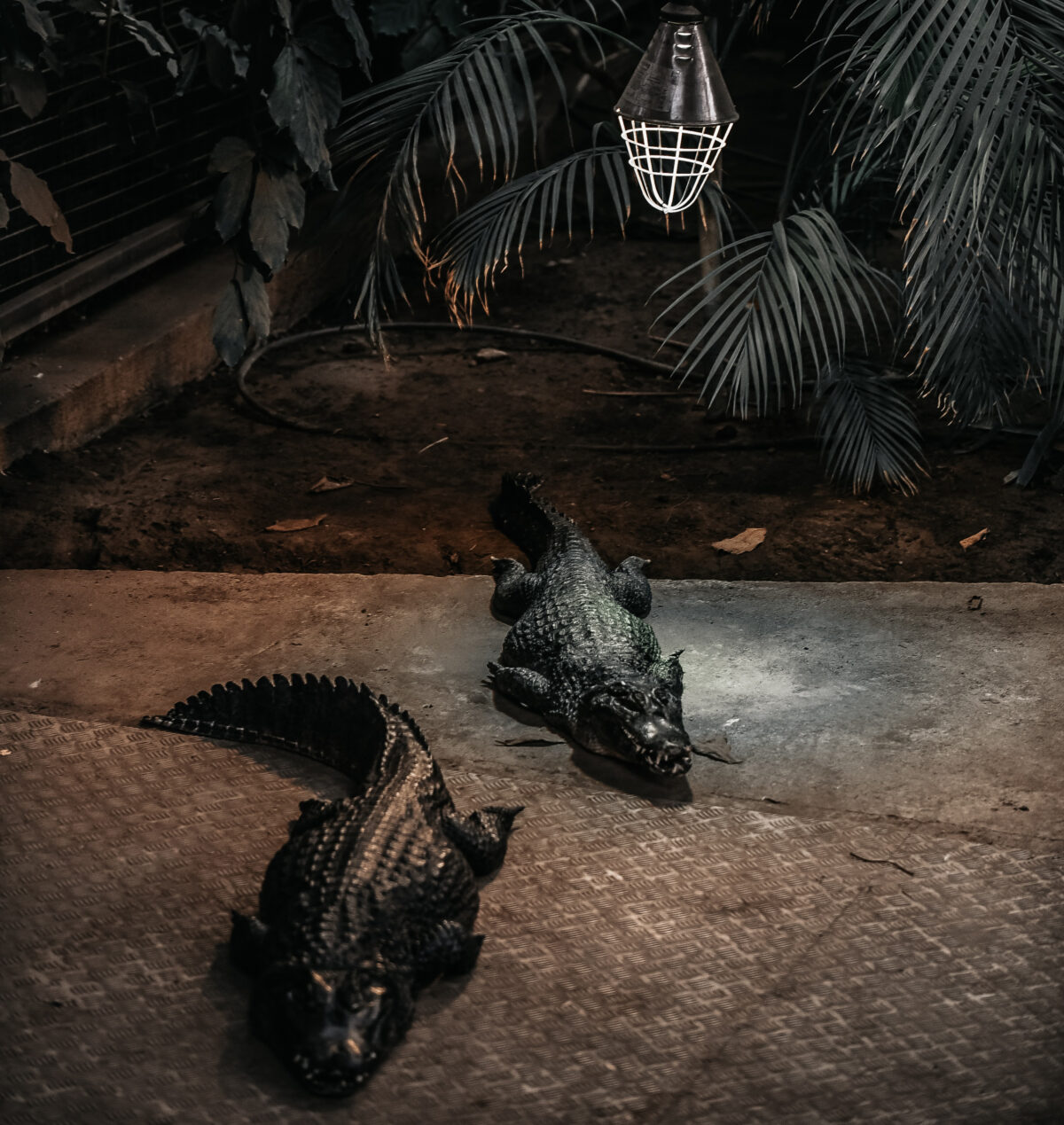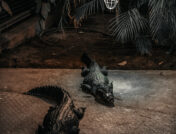Moving to the Sunshine State? Get to Know Your New Neighbors: Florida’s Wildlife

From the coral reefs of the Keys to the cypress swamps of the Panhandle, Florida’s diverse habitats are home to an incredible parade of wildlife. Nowhere else can you see reclusive alligators, playful manatees and beautifully plumed water birds all in a single day—and sometimes, right in your own backyard!
Hike through our enchanted forests—havens for black bears, Florida panthers and bobcats. Canoe or kayak along riverbanks sprinkled with exotic waterbirds, or relax on a guided nature cruise. Take a moonlit summer walk with nesting sea turtles; dive sunlit waters for a colorful show of sea life.
You’ll no doubt have chance encounters with our creatures, great and small. Follow this guide to wildlife sites and seasons, and you’re sure to meet with success the real Florida natives.
American Alligator
An alligator can chomp down its toothy jaws with a 3,000-pound snap. This official state reptile averages six to twelve feet in length and can sprint with blurring speed. Alligators can be safely sighted at many of our parks and wildlife refuges. They are most abundant during May, the peak of mating season. They are dormant and least likely to be seen in cool, winter months.
Rule of Thumb for Florida Residents: If there is a body of freshwater, assume there may be an alligator or two living there. If you see one, remember, they are more scared of you then you of them—but keep your distance. Never walk your pets or children along canals or edges of retention ponds, lakes and for golfers, let your ball go!
American Crocodile
Crocs have narrower snouts than alligators, grow slightly larger and shy from human contact. Crocodiles inhabit salt or brackish water, unlike alligators, which prefer fresh water. This rare prehistoric animal lives in the upper Keys at Key Largo and in the Everglades, the only American crocodile habitat remaining in the U.S. Breeding season is March through October.
Ants
The most common types of ants in Florida can be grouped as either house-infesting, yard-infesting, and carpenter ants. Ants are known for loving sugary, sweet substances. While they prefer sweets, they will eat most anything edible, from fruits to vegetables to meat. They need water to survive, which can also be an attractant. Ants are usually harmless to the health of humans, but fire ants can bite and sting if disturbed. The stings are painful, almost like a burn, and some people may need to seek medical attention if an allergic reaction occurs.
Rule of Thumb for Florida Residents: Be sure to schedule annual ant pest control. You’ll most likely have carpenter, argentine, acrobat, pavement, or sugar ants. The pest control company will be able to determine which type of ant control is needed based on the type of ant. Always keep food sealed or in a sealed container in cupboards or pantries or keep sweet foods in the refrigerator.
Armadillo
If at night you hear a sound like an elephant crushing palmetto fronds underfoot, chances are it’s a five-pound armadillo. Armadillos look like tiny dinosaurs, and thousands of years ago stood 3-1/2 feet tall and weighed about 600 pounds. Because they lack the protection of a fur coat, they prefer temperate weather and burrow in extreme cold or heat. In summer, they are most active during the cool of the evening, and in winter, during the warmest part of the day.
Bald Eagle
A national symbol since 1782, this true American bird is the only eagle unique to North America. The southern variety favors feathering its nest in Florida—we support more breeding bald eagles than any other state! They mate for life, building huge nests in the tops of large trees near rivers, lakes, marshes or other wetland areas. See them year-round at Marco Island, an official Bald Eagle sanctuary, or nesting at Merritt Island National Wildlife Refuge.
Birds
Florida is unique as a state. There’s no other place quite like it. Its birds, too, are rather unique. Most places are near water. So backyard bird lists often feature herons and egrets and ibises and other fly-over waders and water birds.Interestingly, though, the most common backyard feeder birds are similar to other states on the East Coast. The most common species in Florida is Northern Cardinal.
Based on your area, beyond egrets and ibises, you will see pelicans, roseate spoonbills, blue herons, morning doves, woodpeckers, mockingbirds, warblers, cranes, sandpipers, seagulls, and more!
Bobcats
If you’re wild about cats you’ll be fascinated by these beautiful felines. Named for their short or “bobbed” tail, they are about twice the size of house cats and sport razor sharp teeth and claws. Shy and elusive, the bobcat prefers woody or grassy areas, but can be sometimes be seen along deserted roads at dawn and dusk hunting for small rodents. They are active year round, but are rarely seen during the day except during breeding season, December to April.
Butterflies
More than 160 species of these winged wonders of the insect world breed here, and about another 200 have been recorded as passing through. A large number of them are not found anywhere else in North America. From the Panhandle to the Keys, there are many sensational spots to see our beautiful butterflies, among them, The John Pennekamp Coral Reef State Park at Key Largo and St. Marks National Wildlife Refuge, home to migrating Monarch butterflies. Also, there’s a butterfly rainforest habitat at the Florida Museum of Natural History in Gainesville, home to several hundred native and exotic butterflies on any given day.
Cane Toads
The cane toad (also known as the bufo, giant or marine toad) is a large, nonnative amphibian that has been introduced into Florida. Cane toads are considered an invasive species and are poisonous to most animals that try to bite or consume them. The FWC encourages landowners to kill cane toads on their own property whenever possible. Cane toads are not protected in Florida except by anti-cruelty law and can be removed from private property year-round with landowner permission.
Cane toads generally range in size from 6 to 9 inches in length. They can be confused with the native southern toad, however, adult cane toads are much larger than adult southern toads which only grow to a maximum of approximately 3 to 4 inches. Cane toads do not have ridges across the head, as seen in the southern toad.
Rule of Thumb for Florida Residents: Cane toads are reddish-brown to grayish-brown with a light-yellow or beige belly and can be uniform in color or have darker markings around the body. They have enlarged glands behind the eyes, which angle downward onto the shoulders. The glands secrete a potent milky-white toxin (bufotoxin) as defense against predators including domestic pets. Please note, the cane toad can be deadly for your pets.
Florida Black Bear
Like Winnie the Pooh, Florida black bears love honey; but also honeybees, fruits, nuts, twigs and small animals. These timid teddies have curved claws for climbing the trees of our national forests. The most bountiful bear-sightings occur in May, followed by June, August and September.
Rule of Thumb for Florida Residents: Keep your trash well-covered. If you know your area has had black bear sightings, keep your trash bins in the garage until trash pick-up day. If need be, bear-proof bins can be purchased. Check with your local Fish + Wildlife Services for more information.
Florida Panther
Biologists use radio collars to study the small number of panthers remaining in South Florida. The Florida panther is one of the most rare and endangered mammals in the world. They are active at night and rest during the day, and are usually found in the pinelands, hardwood hammocks and mixed swamp forests of the Everglades, at Fakahatchee Strand Preserve State Park and at the Florida panther and Ten Thousand Islands National Wildlife Refuge. This cool cat is actually a subspecies of cougar.
Insects
There are over 1,000 species of insects found in Florida. But to learn the most common, such as beetles, mosquitoes, grubs and yes, “Palmetto bugs”, check out this guide here.
Lizards
Lizards, geckos, skinks, and iguanas can be found all over Florida. Florida is home to 15 native lizard species and 34 exotic species. The native lizards can be found in upland habitats, like hot, dry scrubs or pine flatwoods. Nonnative lizards can be found throughout the state and are outcompeting several native lizard species.
Some people might consider lizards a nuisance or creepy, but these reptiles are actually very beneficial to ecosystems and humans. They are vital to different food chains and control pests in agricultural fields and in yards. Lizards are not only predators to crickets, cockroaches, ants, and beetles, but they are also important prey for other larger predators, like snakes. They keep an important check on insect and rodent populations, which makes them beneficial to property owners and farmers.
Lizards can be super fun to observe and even catch at times, but just like snakes, make sure to use extra caution when around any lizard, or reptile, that may be unknown to you.
Snakes
A majority of Florida snakes are harmless. Of the 50 established species found in Florida, only 6 species are venomous.
Snakes defend themselves mostly by fleeing, but they may bite if captured and harmed. However, biting is not a sign that they are dangerous, it is just the only way that most snakes have to defend themselves. Some snakes might also exude a smelly musk or defecate on the human or other animal that is threatening them.
If you find a snake and do not know whether it is non-venomous (harmless) or venomous. The safest thing to do is leave it alone. Regardless of what some people say, Florida snakes are not aggressive, and unless they are cornered, most will flee when they see you.
If you have snakes around your house: If you find a snake in your backyard, swimming pool, or garage, do not try to kill it! Instead, try to identify it and if it is non-venomous, appreciate it and leave it alone just as you do with songbirds in your garden.
All snakes are carnivorous and a benefit to humans. For example, ratsnakes eat rodents such as mice and rats, and kingsnakes eat these rodents as well as other snakes, including venomous snakes. If it is a small species like a Ringneck Snake or Crowned Snake, they are helpful in your garden where they can do their job eating little pest insects.
If you are bitten by a snake: Most people are bitten on the hands and arms when they are handling or trying to kill a snake. Therefore, if you are uncertain of its identity do not try to catch or even kill a snake.
For a short time after a snake is killed, its reflexes may continue to work. Those reflexes typically cause the body to writhe slowly, but poking or prodding a freshly killed snake can cause a convulsive contraction and even a bite, so do not handle a newly killed venomous snake.
Stay calm, remove any rings that could restrict circulation if tissues swell, keep the bitten limb below the level of the heart.
The only acceptable treatment for venomous snakebite, involves the use of antivenin. So if you or someone else is bitten by a venomous snake, seek immediate attention at the nearest hospital or medical facility.
Spiders
Spiders found in Florida include 59 unique species from confirmed sightings by contributing members of Spider ID. It is important to remember that spiders seen in Florida are not bound by the territorial lines decided on by humans, therefore their distribution is subject to change. Occasionally, spiders can be found well outside of their known range due to being intentionally or accidentally transported by humans in cars, luggage, and other belongings. For a pictorial reference guide, visit Spider ID.
Turtles + Tortoises
More than 30 species of turtle call Florida home. While the majority are primarily aquatic, several varieties live on the land such as box turtles’ and gopher tortoises’. Other species of turtles include sea turtles, softshell, snapping, freshwater and tortoise.
Turtles are very beneficial and are a biological indicator species. Biological indicators are species that can be used to monitor the health of an environment or ecosystem such as with frogs and salamanders.
All turtles play crucial roles in their ecosystems because turtles are omnivores and feed on animals and plants. Turtles also provide seed dispersal, vegetation management, insect also snail control, nutrient cycling, and keep the water clean by scavenging dead animals as well as preying on weak or sick individuals or consume algae that could deplete oxygen from the water if grown without control.
***
References
Visit Florida:
https://www.visitflorida.com/en-us/things-to-do/outdoors-nature/florida-wildlife-by-season.html
Florida Musuem: https://www.floridamuseum.ufl.edu/
Photo by Bogdan Pasca on Unsplash













Overall a good overview of Florida wildlife. My only complaint is you forgot the manatees!!! You mentioned them in the introduction, but nothing in the more detailed section. I’m sure that’s an oversight!